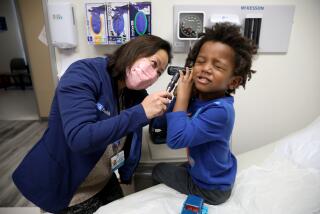Teens: They’re Often the Patients the Health-Care System Forgot
- Share via
Guns. Drugs. Tobacco. Obesity. Sex. Eating disorders. Depression. Teenagers today probably have more reasons to see a doctor regularly than any generation before them.
Studies show that teenagers are savvy enough to know they need medical care or counseling but have a difficult time finding someone, including parents, whom they feel comfortable talking to about the difficult and often highly personal health issues they face.
Yet many studies in the last decade have shown that adolescents are as out of touch with the health care system as their parents are from the music their kids listen to.
Teenagers represent 15% of the U.S. population but make up only 9% of medical visits--a rate that points to an underuse of services, according to a study published last year in the journal Pediatrics.
That could change, however, if child health advocates succeed in prodding both the health-care system and parents of teenagers to wake up.
This week, the Oakland-based child advocacy organization, Children Now, is releasing a detailed report that calls on the nation’s HMO industry to do a better job of improving health care for adolescents and describes some ways to accomplish those improvements.
The report, “Partners in Transition,” details numerous small managed-care programs around the nation that have documented success in improving the health of teenagers. The report acknowledges that managed care is now a major force in health-care delivery and calls HMOs to step up to the challenge of reducing health risks among teenagers.
“There is recognition of the gaps in adolescent health care,” says Lois Salisbury, president of Children Now. “But implementing adolescent programs needs the kind of road map we’ve put together. Because getting it done is not so easy.”
Too Old for Pediatricians, Put Off by Other Doctors
Not easy at all. Adolescents are the lost souls of health care, often having outgrown their pediatrician’s ability to make them feel comfortable and meet their needs but unwelcome by practitioners who treat adults. One survey of HMO doctors found that only 31% of pediatricians and 34% of internal medicine doctors said they liked working with adolescents. Half of obstetrician-gynecologists and 61% of family-practice doctors said they enjoyed teen patients.
Although physicians can obtain board certification in adolescent medicine, only a few hundred nationwide have done so, according to the American Society for Adolescent Medicine, which has about 1,000 physician members.
“We’ve not done a great job” with adolescents, says Dr. James Perrin, director of the division of general pediatrics at Massachusetts General Hospital in Boston. “It’s easy to do the ordinary doctoring things. But that is probably not going to meet the needs of many adolescents.”
Given the lack of professional expertise, it’s no surprise that teenagers often say they receive inadequate service. One study published last year in the journal Pediatrics found that nearly one-half of adolescent office visits included no counseling or education, and only 3% of teens received counseling on such crucial issues as smoking cessation, sexually transmitted diseases and weight control.
Because adolescents rarely suffer from a bad cold--much less a serious disease--adults often assume they are in robust health. However, according to studies, many teenagers today have undiagnosed eating disorders, depression or sexually transmitted diseases, or are developing poor health habits, such as sedentary lifestyles or smoking, that will carry into adulthood.
Patients Can’t Access Care on Their Own
Adolescents often lack the maturity, experience and financial resources to access the health-care system on their own, however.
A study published in December in the Journal of the American Medical Assn. found that 18.7% of adolescents didn’t see a doctor for a medical problem in the last year.
The reasons they gave for not getting care included thinking the problem would go away (63%), fear about what the doctor would do or say (15%), inability to pay (14%), concerns about confidentiality (11.5%), inability to get parent or guardian to accompany them to get care (11.7%) and difficulty making an appointment (8.9%).
And once teens do get to the doctor’s office, experts say they don’t always get the appropriate care. That’s why, for example, the American Academy of Pediatricians last year, recognizing the problem, urged its members to be ready, willing and able to dispense contraceptives if they are going to see teenage patients.
But because many physicians now work within managed care, that is the system that must assume leadership on adolescent health care, Salisbury says. Managed-care organizations, which often tout their ability to emphasize prevention and provide a team approach to complicated health issues, is poised to do better by their teen patients, she says.
“The features, structures and incentives that managed care have are real, although not all of them have been realized,” Salisbury says. “The managed-care model, at its best, really has plenty of incentive to emphasize the preventive in ways that the classic health-insurance model never had.”
For example, one study found that an HMO can save from $308 to $946 in costs associated with pregnancy and treating STDs by providing sexually active teenagers with contraceptives, the Children Now report shows.
“The biggest health risks to adolescents are risks that they themselves take,” Salisbury says. “You prevent a teen pregnancy and you have saved your plan money.”
This is the second time Children Now has offered a blueprint to the managed-care industry on how it can improve the health of children. The agency released a report on early childhood two years ago that, Salisbury says, was well-received.
The “Partners in Transition” report has been endorsed by the American Assn. of Health Plans, the leading HMO industry organization.
Adolescent health “is an area of focus for our community,” says Susan Pisano, a spokeswoman for the group. “What Children Now has done is bring all this information together in a format that is very, very useful for plans. They’ve given us a wide variety of the kinds of strategies that will work. For example, a CD-ROM [to educate teens on a topic] works, the written stuff didn’t.”
Critics Say Managed Care Gives Teens Short Shrift
Others seriously doubt managed care’s ability to make improvements in adolescent preventive care.
Dr. Victoria I. Paterno, a Santa Monica pediatrician whose practice includes a lot of teenage patients, says she will not accept HMO patients because the reimbursements fail to cover the time doctors need to spend on prevention counseling with teenagers.
“Managed care limits how much time you can spend with patients,” she says. “If you expect to have any relationship with a teenager, you have to spend time. The reality is that insurance companies don’t reimburse enough.”
Perrin, of Massachusetts General, says managed care sometimes is blamed unfairly for such problems and can provide more time for complicated cases.
And other experts point out that the health-care system is only part of the reason teenagers don’t receive adequate care. Adolescents can be tough customers.
While most states have patient-confidentiality laws that allow teens to receive such medical services as birth control, prenatal care and treatment for sexually transmitted diseases without their parents’ consent or knowledge, teens often are unaware of their rights or are ambivalent about taking responsibility for their care.
The JAMA study in December pointed out that while many teens want their parents or other adults to make their doctor’s appointments, provide transportation and lend support, they also want privacy and confidentiality.
Parents too often fail to emphasize the need for an annual checkup or don’t make the effort to find a provider that their teenager is comfortable with. For instance, studies indicate that many teen girls would like to have female doctors or nurses. Other adolescents are mortified at the idea of returning to the pediatrician’s office with the Big Bird wallpaper.
Teenagers, parents and doctors also need to work out such basic questions as whether the parent will leave the exam room.
“When I started out in this field, I used to gently remove parents from the room when I had a teenage patient,” Perrin says. “I still do that. But now, I routinely spend time with the parents to talk about how important it is to stay involved with the adolescent and to talk about adolescent health issues like drugs, sex and alcohol.”
(BEGIN TEXT OF INFOBOX / INFOGRAPHIC)
Risk Factors
Although teens are adopting better health habits in some areas, key risk behaviors such as marijuana and tobacco use are on the rise.
Health Risk: Never or rarely wears bicycle helmet
1991: 96%
1997: 88%
*
Health Risk: Has had sexual intercourse
1991: 54%
1997: 48%
*
Health Risk: Currently smokes cigarettes
1991: 28%
1997: 36%
*
Health Risk: Currently uses marijuana
1991: 15%
1997: 26%
*
Health Risk: Used birth control pills during last sexual intercourse
1991: 21%
1997: 17%
*
Health Risk: Participates in vigorous physical activity
1991: 66%
1997: 64%
*
Health Risk: Has ridden with a drunk driver
1991: 40%
1997: 37%
*
Health Risk: Has engaged in episodic heavy drinking
1991: 31%
1997: 33%
*
Health Risk: Has attempted suicide
1991: 7%
1997: 8%
Source: Centers for Disease Control and Prevention Youth Risk Behavior Survey
(BEGIN TEXT OF INFOBOX / INFOGRAPHIC)
Asking the Tough Questions
Researchers at Rand and UCLA surveyed 2,026 high school students to determine what issues doctors had or had not discussed with them during office visits.
Percentage of teens who said their doctors discussed the following subjects:
AIDS prevention: 39%
Condum use: 37%
Sexual activity: 15%
How to say no to sex: 13%
Sexual orientation: 8%
Source: Archives of Pediatric and Adolescent Medicine






